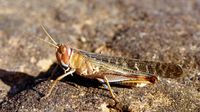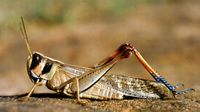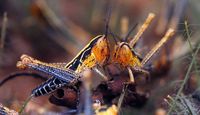Rhammatocerus schistocercoides
| Literature database |
|---|
| 30 articles sorted by: |
| • year (recent ones first) |
| • research topics |
| • countries/regions |
| • host plants |
| • list of natural enemies |
Rhammatocerus schistocercoides (Rehn, 1906) - (Mato Grosso locust)
This locust is found in parts of South America (Brazil, Colombia, Peru and Venezuela). Large outbreaks can develop in the State of Mato Grosso in Brazil, with the locust forming dense hopper bands as well as swarms. These can cause substantial damage to crops like rice, maize and sugarcane. Such large outbreaks have occurred for example between 1984-1988 (e.g. see Barrientos, 1995).
The typical habitats of the locust are the savannas of central South America, like the "cerrado" region of Brazil. Rangelands as well as cereals and sugarcane grown in these areas are at risk of being damaged. Hopper bands have a size ranging from an area of a few hundred to several thousand square meters, with a density of 5-10,000 hoppers per m2 in the 1st instar to 250-500 per m2 in the last instar. The bands might move several hundred metres per days or are more sessile. Adult swarms might have a diameter of up to 1 km. They fly at low altitudes (up to 10 m high) and cover only a few hundred metres to 2-3 km per day. For a review see Lecoq & Magalhães (2008).
| Vernacular names | |
|---|---|
| • English: | Mato Grosso locust |
| • Español: | langosta llanera |
R. schistocercoides is often called a grasshopper and nymphs do not change their colour during outbreaks like many locusts do. However, it adopts a gregarious behaviour when environmental conditions are favourable for multiplication, forming hopper bands and swarms. This change to a gregarious phase fits the definition of a locust by Song (2011). Adults are around 4-5 cm long with distinct colour markings. The basic colour is light brown and there are black marks on the head and thorax. Most of the hind femora are bright blue on the inner side. The tibia are orange at their base, with the distal parts and the tarsi also being bright blue.
- Other images of Rhammatocerus schistocercoides (Flickr - click to enlarge)



